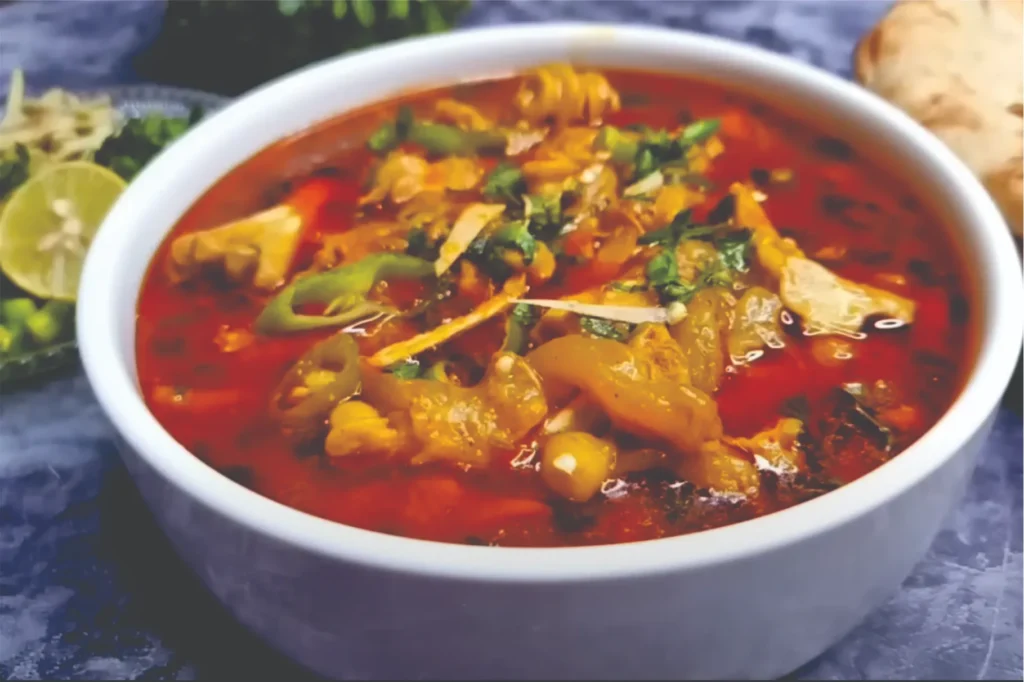Origin
Paya Curry is a traditional dish from the Indian subcontinent that is incredibly popular in India, Pakistan, and Bangladesh. This Paya Curry recipe has its roots in Mughlai cuisine, originating from the royal kitchens of the Mughal Empire. Paya (meaning ‘trotters’ in Hindi and Urdu) was once a low-budget dish but has since become a staple in households. The Paya Curry recipe is made using nutrient-rich parts of the animal, with cuts like ribs, shoulders, and the long, tubular spine being either boiled into soup or roasted with a few spices. Traditionally, Paya Curry recipe was made in winter to provide warmth and nutrition.

Category
- Dish Type: Main Course
- Subcategory: Non-Vegetarian, Spicy Food, Dinner, South Asia
- Seasonal: Winter
Ingredients of Paya Curry
For 4, 6, 8, and 10 servings:
| Ingredient | For 4 Servings | For 6 Servings | For 8 Servings | For 10 Servings |
|---|---|---|---|---|
| Goat/Lamb Trotters (Paya) | 4 | 6 | 8 | 10 |
| Onions (finely chopped) | 2 medium | 3 medium | 4 medium | 5 medium |
| Tomatoes (pureed) | 2 large | 3 large | 4 large | 5 large |
| Ginger-Garlic Paste | 2 tbsp | 3 tbsp | 4 tbsp | 5 tbsp |
| Turmeric Powder | 1 tsp | 1.5 tsp | 2 tsp | 2.5 tsp |
| Red Chili Powder | 1.5 tsp | 2 tsp | 2.5 tsp | 3 tsp |
| Coriander Powder | 1.5 tsp | 2 tsp | 2.5 tsp | 3 tsp |
| Garam Masala Powder | 1 tsp | 1.5 tsp | 2 tsp | 2.5 tsp |
| Cumin Seeds | 1 tsp | 1.5 tsp | 2 tsp | 2.5 tsp |
| Green Chilies (slit) | 2 | 3 | 4 | 5 |
| Fresh Coriander (chopped) | 2 tbsp | 3 tbsp | 4 tbsp | 5 tbsp |
| Cooking Oil/Ghee | 4 tbsp | 6 tbsp | 8 tbsp | 10 tbsp |
| Water | 4 cups | 6 cups | 8 cups | 10 cups |
| Salt | To taste | To taste | To taste | To taste |
Nutritional Information for Spices used in Paya Curry
| Spice | Calories (per tsp) | Key Nutrients |
|---|
| Turmeric Powder | 9 | Iron, Vitamin C, Antioxidants |
| Red Chili Powder | 16 | Vitamin C, Vitamin A, Capsaicin |
| Coriander Powder | 5 | Calcium, Iron, Vitamin K |
| Garam Masala Powder | 8 | Iron, Manganese, Magnesium |
| Cumin Seeds | 8 | Iron, Magnesium, Calcium |
Instructions of Paya Curry
- Prepare the Paya:
- Wash the trotters extremely well with water and wash off hair and dirt.
- Soak them in salted water for 20–30 minutes, then boil to soften (optional if you want it for tender meat).
- Cook the Base:
- Heat oil/ghee in a large pot.
- Put cumin seeds and let them splutter.
- Then add chopped onions and stir fry till golden brown.
- Add ginger-garlic paste and mix well; sauté for 2–3 minutes, until the raw smell of ginger-garlic goes away.
- Add Spices and Tomatoes:
- Add 1/4th tsp turmeric, 1/2 tsp red chili, 1/2 tsp coriander powder and salt. Stir well.
- Add tomato puree; cook until oil separates.
- Combine Paya and Base:
- Stir in the boiled trotters, and combine well.
- Cook over medium heat for 10 minutes to allow flavors to infuse.
- Simmer:
- Pour in water and bring the curry to a boil.
- Grab the heat, cover it all up and simmer for 1.5–2 hours for soft trotters and thick gravy.
- Finish:
- Add garam masala powder, slit green chilies, and fresh coriander.
- Let it simmer for 5 more minutes.
- Serve:
- Serve hot with naan, roti, or steamed rice.
Doctor’s Advice about Paya Curry
Who Can Benefit:
For people with joint pain or weak bones: Rich in collagen ensuring your joint bones health.
People in need of sustenance: Its high protein content makes it well-suited for post-illness recovery.
Who Should Avoid:
People with High Cholesterol : Paya curry has fats that can spike cholesterol levels.
Diabetics: May not be suitable for those with digestive sensitivity due to the richness and spices.
Conclusion
Paya curry is a rich, kharchari, and hearty dish with a silky texture and robust spices. Its scent is soothing, which is why many families think of this recipe as one that is best for winter or family occasions. Ideal for festivals, Eid celebrations or weekend feasts, it is best served with naan or rice.
If you want to know a specific recipe or want to contribute your own recipe in our blog, you may contact us at contactus@flavorsofnation.com or leave a message in our social media channels.
